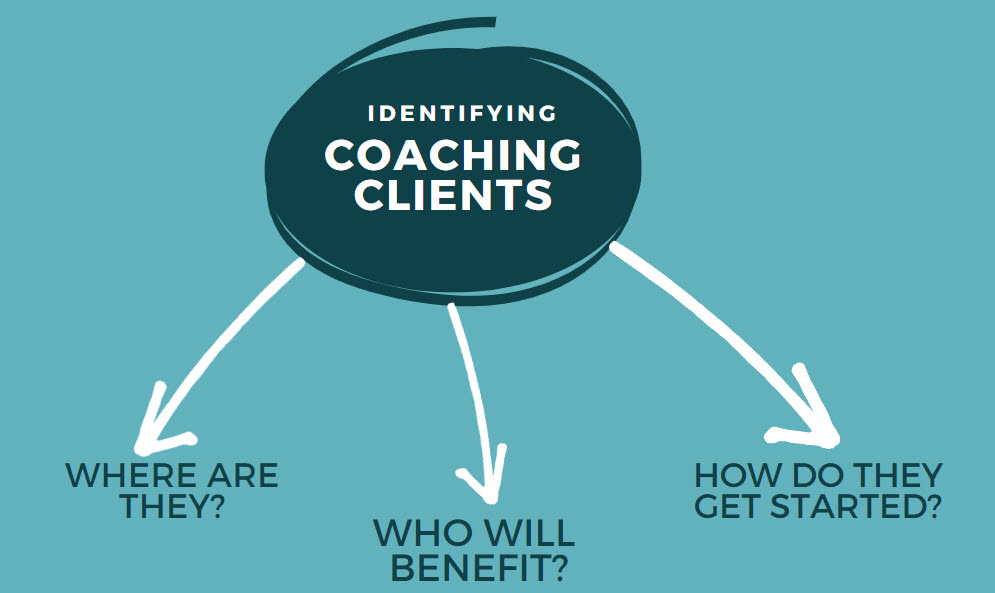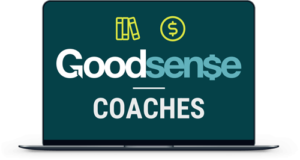
Contents
Your stewardship coaching ministry is ready. You have committed coaches who look forward to serving clients. But where do you find the clients? How do you “drum up business” for your coaching ministry?
For some churches, the problem isn’t so much finding potential clients – it’s that there are way too many for the size of the coaching ministry! For other churches, long gaps in taking in new clients discourage coaches and make them feel that their service is not valuable.
Your coaching ministry needs clients. And there are people in your church who need your coaching ministry. How do you link the coaches with those who need them? How do you find the people who will benefit from stewardship coaching while weeding out those who won’t?
Start with the “Why”
First, it helps to be crystal clear about the “why” of your stewardship coaching ministry. What are you looking to achieve? Who are the people you’re looking to serve, and what results do you hope to produce in their lives? While the details may vary a bit from church to church, some general principles can guide your thinking.
The stewardship coaching ministry is about walking alongside people who are struggling in their stewardship journey. It’s not about giving financial advice or wealth-building. (We discuss this further in our article, “Equipping Financial Coaches for Your Stewardship Ministry.”)
As a result, the primary audience for a stewardship coaching ministry is those who are facing financial difficulties. But not everyone who fits this description is a good candidate for stewardship coaching. Some may have a plan and may be on their way to financial stability already. Others may not be ready for the commitment that the coaching process will entail. Still others may have financial goals that aren’t compatible with stewardship coaching.
If you start with a clear understanding of your coaching ministry’s goals – the fruit you hope to produce in the lives of clients – you’ll be on the right track to identifying those who can benefit from your ministry.
Identify the “Where”: Finding Coaching Clients
So once you know the type of client you’re looking for, where do you find them? One thing NOT to do is make a church-wide announcement! You may find that you get overwhelmed with requests from people who don’t fully understand the purpose of the ministry, and this may hinder you in getting to the people God is calling you to serve.
A good starting point is to work with ministry leaders to identify people in their ministries – volunteers and participants – who might benefit from stewardship coaching. Ministry leaders understand the people who are participating in their ministries. They may not always know exactly who needs stewardship coaching, but they have relationships with people who can answer that question.
As you work with these ministry leaders, it’s important that you be able to clearly articulate the benefits that stewardship coaching can bring to those who need it. People who are struggling financially often find that their lives are dominated by financial concerns. This focus can limit their capacity for spiritual growth, as well as causing stress in marriage and family relationships.
Churches are in the business of making disciple-makers. Jesus raises up leaders including apostles, prophets, evangelists, pastors, and teachers in order to equip the body for works of service (Ephesians 4:11). Paul charges Timothy to entrust truth to people who will be able to teach others (2 Timothy 2:2). The New Testament repeatedly shows the priority of spiritual multiplication through disciples making disciples who make disciples, etc.
But it’s hard for volunteers and participants in your church’s ministries to carry out the charge of making disciples if they’re saddled with financial concerns. As a result, ministries empower their people to both be disciples and make disciples when they help free them from financial bondage.
Any ministry leader could potentially be a partner in identifying coaching clients, but here are a few suggestions offered as thought-starters.
Benevolence Ministry
The Benevolence Ministry is an obvious place to start. Benevolence is often focused on aid – a short-term solution to an immediate problem. But others come with longer-term needs – needs that require more of a “development” approach than an “aid” approach. In these cases, part of the help that the Benevolence ministry can bring is to link clients up with stewardship coaching, to help address the larger financial issues. Of course, not all benevolence cases would benefit from coaching, but many would.
Marriage Ministry
Over and over again, we hear that finances are the most common problem for marriages. Financial difficulties add to marital stress and are a large contributor to divorce. Often, couples start off on different pages financially – with contrasting backgrounds and disparate expectations. Communication over finances often generates more emotion than real progress. Couples in this situation can benefit from undergoing stewardship coaching together – not only to learn Scriptural principles and practical tools, but also as a means of communicating and developing unity in the area of stewardship.
Stewardship Ministry
Yes, that’s right, look in your own back yard! Chances are, if you run any kind of church-wide stewardship program or emphasis, some of the participants will emerge with a transformed understanding of stewardship and a strong desire to grow in this area, but needing some individual guidance to help them walk the path. One good way of identifying these potential clients is to survey those who participate in the stewardship program. Explain the nature and purpose of stewardship coaching (and be clear about who you’re trying to help) and ask participants in the program if they believe they would benefit from coaching.
Small Group Ministry
In churches with a small group ministry, the small groups are typically the places where people are best known. As a result, small group leaders may be in some of the best positions to identify participants who may be struggling financially. Depending on your church’s small group ministry structure, there may be opportunities to communicate the stewardship coaching ministry to small group leaders and help them identify potential needs in their groups.
Other ministries
People throughout your congregation are struggling financially. Due to preoccupation with their struggles, it’s possible that many of them aren’t regularly participating in any ministry. But those who are participating can be found in many places. Your college and young adult ministry is populated with participants considering or facing significant student loan debt. Adult ministries, women’s ministries, men’s ministries – all of these likely have people who are struggling financially. This makes all of them potential audiences for your stewardship coaching ministry.
Narrowing the “Who”: Filtering Coaching Clients
In each of these places (and others), there are people who could benefit from stewardship coaching. But how do you know who is actually ready for a coaching relationship? There are several filters you can use, but here are a few to start with:
Purpose: Stewardship vs. Wealth-building
We’ve mentioned before that the coaching ministry is about financial stewardship, not about wealth-building. So individuals who are coming for financial advice, investment direction, or similar needs are not the candidates your ministry is looking for.
By the same token, the focus of the coaching ministry is to help people who are struggling financially get to a point of stability. So it’s not primarily for people who are doing well financially. Most of your candidates will likely have a significant amount of debt and encounter difficulty making ends meet. Of course, stewardship can still be an issue for those who are well-off, but the guidance they need is not the focus of the coaching ministry.
Preparation: Completion of a Stewardship Program
Financial coaching will be most effective if clients understand basic Biblical financial principles and are familiar with tools like the spending record, spending plan, etc. This puts the coach in a position of assisting the client with questions rather than attempting to teach the basic concepts. This will enable quicker progress and be a better use of both the coach’s and the client’s time than running a 1-1 stewardship training.
As a result, consider making completion of a stewardship program such as FreedUp a prerequisite for stewardship coaching. This will give a client the concepts, principles, and language around stewardship that they need in order to maximize benefit from the coaching relationship. The picture is this: In the stewardship program, the client learns what they need to do and why; in the coaching relationship, they get assistance with the how.
Perseverance: Commitment to the Process
Some people will come for coaching seeking an easy process or a quick solution. Most of them didn’t get into their situation overnight, and they won’t get out overnight. There needs to be a level of commitment to a relationship and process over time and to ongoing stewardship after the coaching relationship is over. Otherwise, the client won’t make any lasting progress in their financial discipleship. (We’ll talk more about this in the next section.)
Getting to the “What”: Client Intake
So, you know places to find clients and who makes a good client. But how do you actually get them started?
Start with an application process that includes a Client Profile form. If you’d like a sample Client Profile, you can download one at the bottom of this article. This form should include basic client personal information (family, employment, etc.); financial information (assets/liabilities, income, expenses), and an indication of goals for the process.
This form serves a couple of purposes. First, it provides a starting point the coach can use to understand the client’s situation. From there, the coach can get a good idea of where the client is financially, the areas that need to be addressed, and key questions to ask the client in the initial meeting.
Second, the Client Profile gives an idea of the client’s level of commitment to the coaching process. We talked about the requirement of perseverance on the part of the client in order to make the process successful. Because the Client Profile requires some work in order to put the information together, it provides insight into how well the client will persevere through the process. If the client is not able or willing to go to the level of detail required to fill out the Profile, then they won’t persevere through the coaching process.
Finally, the Client Profile gives you an idea of which coach or coaches might be a good fit for the client. If the client is single, you probably want to try to match them with a coach of the same gender. If the client is older, you might try to match them with an older coach. If you have a coach who is a single mom, you might pair a single mom client with her. You may not always be able to create the ideal pairing, but the Client Profile gives you a good place to start.
The Bottom Line
To be successful, your coaching ministry needs three primary elements:
- Trained, committed coaches
- An effective coaching process
- The right clients
Finding the right clients starts with collaborating with other ministries in your church to help identify potential candidates. Ministries and their participants will benefit as finances and lives are transformed through Biblical stewardship. Filtering those clients to ensure they are a good fit for coaching helps to keep your coaches focused on those who can benefit from the process and who will be committed to the relationship. And having a solid intake process gets the coaching relationship off to the right start.
Putting these elements in place will help you maximize the fruitfulness of your stewardship coaching ministry and the impact you’ll have on the lives of individuals and on your church.
